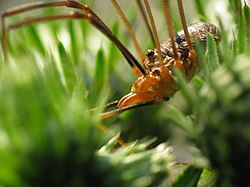Opiliones
Harvestmen are eight-legged arachnids. Even though they are arachnids like spiders, harvestmen are not spiders. They are in the order Opiliones.
| Opiliones Temporal range: Devonian – Recent
| |
|---|---|

| |
| Hadrobunus grandis | |
| Scientific classification | |
| Kingdom: | |
| Phylum: | |
| Class: | |
| Subclass: | |
| Order: | Opiliones Sundevall 1833
|
| Diversity | |
| 4 suborders, > 6,400 species | |

More than 6,400 species of harvestmen have been discovered, although the real number of extant species may be more than 10,000.[1] Well-preserved fossils have been found in the 400-million year old Rhynie cherts of Scotland. Fossil harvestmen look surprisingly similar to modern harvestmen. Apparently, the basic body shape of harvestmen has not changed much.
In some places, harvestmen are known by the name "daddy longlegs", but this name is also used for two other unrelated arthropods: the crane fly (Tipulidae) and the cellar spider (Pholcidae).
Many species of harvestmen are omnivores--they eat anything they can find. Most of the time this is small insects, and some plants and fungi. Some are scavengers.
Harvestmen are not dangerous to humans. None of the described species have poison glands. They are not "true" spiders even though they look like spiders in many ways. For example, harvestmen have no venom or silk glands; spiders have these.
Anatomy
Harvestmen have exceptionally long walking legs compared to their bodies, although there are also some short-legged species. In harvestmen, the two main body sections (the abdomen and cephalothorax) meet at a wide point, so that they appear to be one oval structure. In more advanced species of harvestmen, the first five segments of the abdomen are fused into a "shield" on the harvestman's back called the scutum. In some species, this shield is only present in males. The second pair of legs is longer than the others and work as antennae. This can be hard to see in short-legged species.
The feeding apparatus (stomotheca) differs from other arachnids as they are able to eat their food in chunks, without needing to liquify it. Most species have a single pair of eyes in the middle of their heads, oriented horizontally. However, there are some eyeless species.
Further reading
- Joel Hallan's Biology Catalog (2005)
- Pinto-da-Rocha R. Machado G. & Giribet G. eds. 2007. Harvestmen – the biology of Opiliones. Harvard University Press ISBN 0-674-02343-9
- Pinto-da-Rocha R. & Kury A.B. 2003. Third species of Guasiniidae (Opiliones, Laniatores) with comments on familial relationships. Journal of Arachnology 31: 394-399. PDF Archived 2016-03-28 at the Wayback Machine
- Shultz, Jeffrey W. 1998. Phylogeny of Opiliones (Arachnida): an assessment of the "Cyphopalpatores" concept. Journal of Arachnology 26: 257-272. PDF Archived 2008-12-16 at the Wayback Machine
Opiliones Media
Chilean harvestman (Pachyloidellus goliath)
North European harvestman (Leiobunum rotundum) body
Harvestmen (Opiliones sp.) filmed in Hesse, Germany
Harvestman eating a skink tail
Protolophus sp. cleaning its legs
A male Phalangium opilio, showing the long legs and the tarsomeres (the many small segments making up the end of each leg)
Mites parasitising a harvestman
Rilaena triangularis with several missing legs
Other websites
| Wikimedia Commons has media related to Lua error in Module:Commons_link at line 62: attempt to index field 'wikibase' (a nil value).. |
| Wikispecies has information on: Opiliones. |
- Harvestman: Order Opiliones Diagnostic photographs and information on North American harvestmen
- Harvestman: Order Opiliones Diagnostic photographs and information on European harvestmen
- University of Aberdeen: The Rhynie Chert Harvestmen (fossils)
- National Museum page Classification of Opiliones Archived 2020-11-12 at the Wayback Machine A synoptic taxonomic arrangement of the order Opiliones, down to family-group level, including some photos of the families
References
- ↑ Pinto-da-Rocha R. Machado G. & Giribet G. eds. 2007. Harvestmen – The biology of Opiliones. Harvard University Press ISBN 0-674-02343-9
| Wikimedia Commons has media related to Lua error in Module:Commons_link at line 62: attempt to index field 'wikibase' (a nil value).. |








